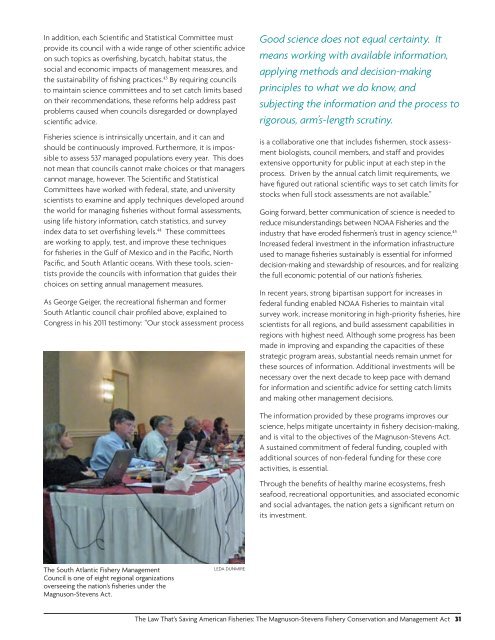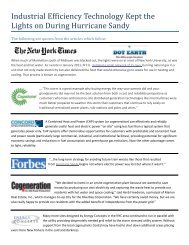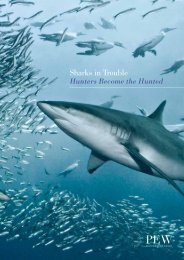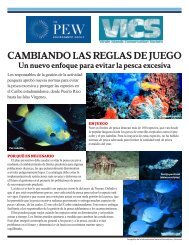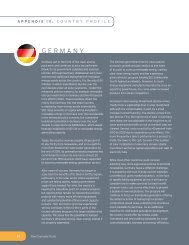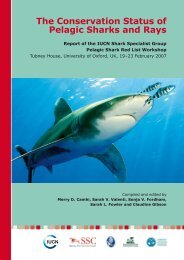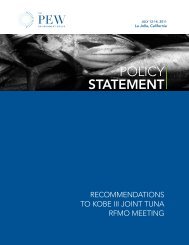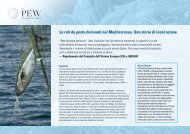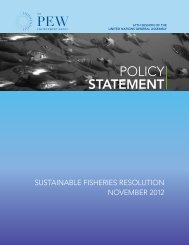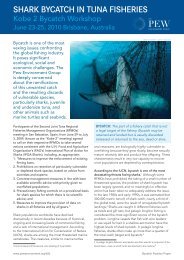The Law That's Saving American Fisheries - Ocean Conservancy
The Law That's Saving American Fisheries - Ocean Conservancy
The Law That's Saving American Fisheries - Ocean Conservancy
You also want an ePaper? Increase the reach of your titles
YUMPU automatically turns print PDFs into web optimized ePapers that Google loves.
In addition, each Scientific and Statistical Committee must<br />
provide its council with a wide range of other scientific advice<br />
on such topics as overfishing, bycatch, habitat status, the<br />
social and economic impacts of management measures, and<br />
the sustainability of fishing practices. 43 By requiring councils<br />
to maintain science committees and to set catch limits based<br />
on their recommendations, these reforms help address past<br />
problems caused when councils disregarded or downplayed<br />
scientific advice.<br />
<strong>Fisheries</strong> science is intrinsically uncertain, and it can and<br />
should be continuously improved. Furthermore, it is impossible<br />
to assess 537 managed populations every year. This does<br />
not mean that councils cannot make choices or that managers<br />
cannot manage, however. <strong>The</strong> Scientific and Statistical<br />
Committees have worked with federal, state, and university<br />
scientists to examine and apply techniques developed around<br />
the world for managing fisheries without formal assessments,<br />
using life history information, catch statistics, and survey<br />
index data to set overfishing levels. 44 <strong>The</strong>se committees<br />
are working to apply, test, and improve these techniques<br />
for fisheries in the Gulf of Mexico and in the Pacific, North<br />
Pacific, and South Atlantic oceans. With these tools, scientists<br />
provide the councils with information that guides their<br />
choices on setting annual management measures.<br />
As George Geiger, the recreational fisherman and former<br />
South Atlantic council chair profiled above, explained to<br />
Congress in his 2011 testimony: “Our stock assessment process<br />
Good science does not equal certainty. It<br />
means working with available information,<br />
applying methods and decision-making<br />
principles to what we do know, and<br />
subjecting the information and the process to<br />
rigorous, arm’s-length scrutiny.<br />
is a collaborative one that includes fishermen, stock assessment<br />
biologists, council members, and staff and provides<br />
extensive opportunity for public input at each step in the<br />
process. Driven by the annual catch limit requirements, we<br />
have figured out rational scientific ways to set catch limits for<br />
stocks when full stock assessments are not available.”<br />
Going forward, better communication of science is needed to<br />
reduce misunderstandings between NOAA <strong>Fisheries</strong> and the<br />
industry that have eroded fishermen’s trust in agency science. 45<br />
Increased federal investment in the information infrastructure<br />
used to manage fisheries sustainably is essential for informed<br />
decision-making and stewardship of resources, and for realizing<br />
the full economic potential of our nation’s fisheries.<br />
In recent years, strong bipartisan support for increases in<br />
federal funding enabled NOAA <strong>Fisheries</strong> to maintain vital<br />
survey work, increase monitoring in high-priority fisheries, hire<br />
scientists for all regions, and build assessment capabilities in<br />
regions with highest need. Although some progress has been<br />
made in improving and expanding the capacities of these<br />
strategic program areas, substantial needs remain unmet for<br />
these sources of information. Additional investments will be<br />
necessary over the next decade to keep pace with demand<br />
for information and scientific advice for setting catch limits<br />
and making other management decisions.<br />
<strong>The</strong> information provided by these programs improves our<br />
science, helps mitigate uncertainty in fishery decision-making,<br />
and is vital to the objectives of the Magnuson-Stevens Act.<br />
A sustained commitment of federal funding, coupled with<br />
additional sources of non-federal funding for these core<br />
activities, is essential.<br />
Through the benefits of healthy marine ecosystems, fresh<br />
seafood, recreational opportunities, and associated economic<br />
and social advantages, the nation gets a significant return on<br />
its investment.<br />
<strong>The</strong> South Atlantic Fishery Management<br />
Council is one of eight regional organizations<br />
overseeing the nation’s fisheries under the<br />
Magnuson-Stevens Act.<br />
Leda Dunmire<br />
<strong>The</strong> <strong>Law</strong> That’s <strong>Saving</strong> <strong>American</strong> <strong>Fisheries</strong>: <strong>The</strong> Magnuson-Stevens Fishery Conservation and Management Act 31


